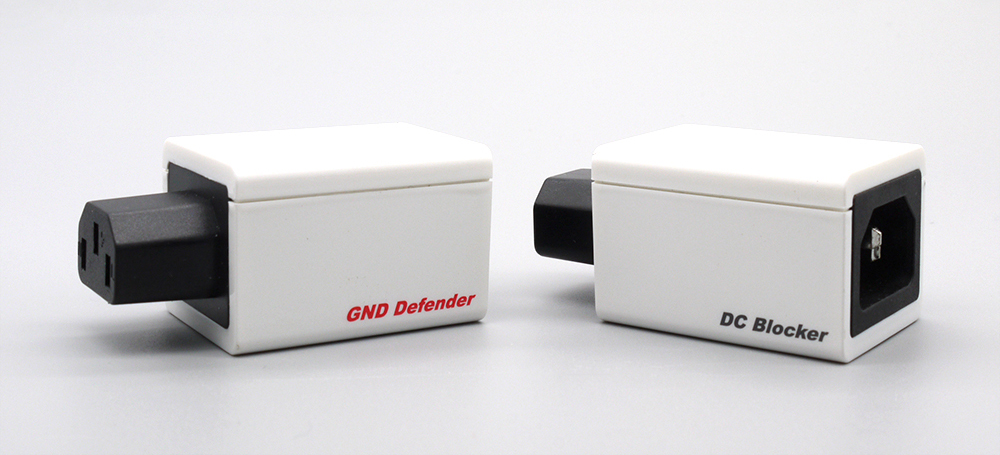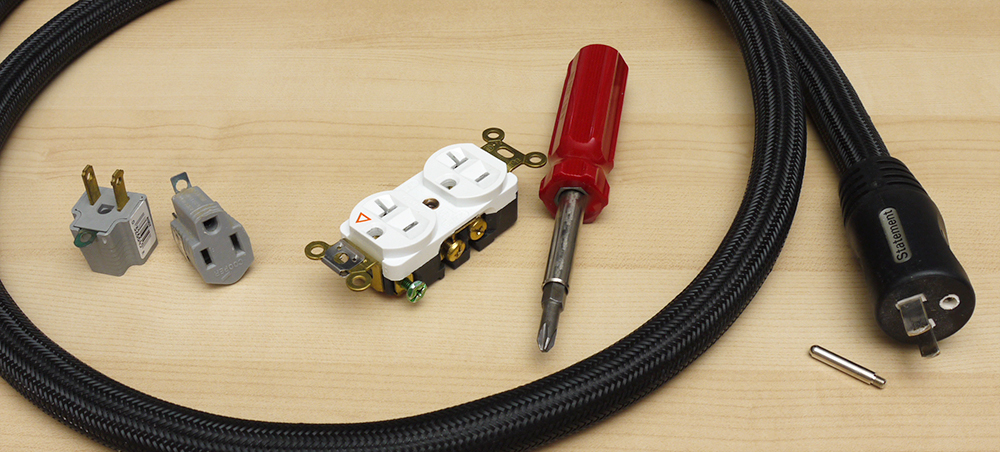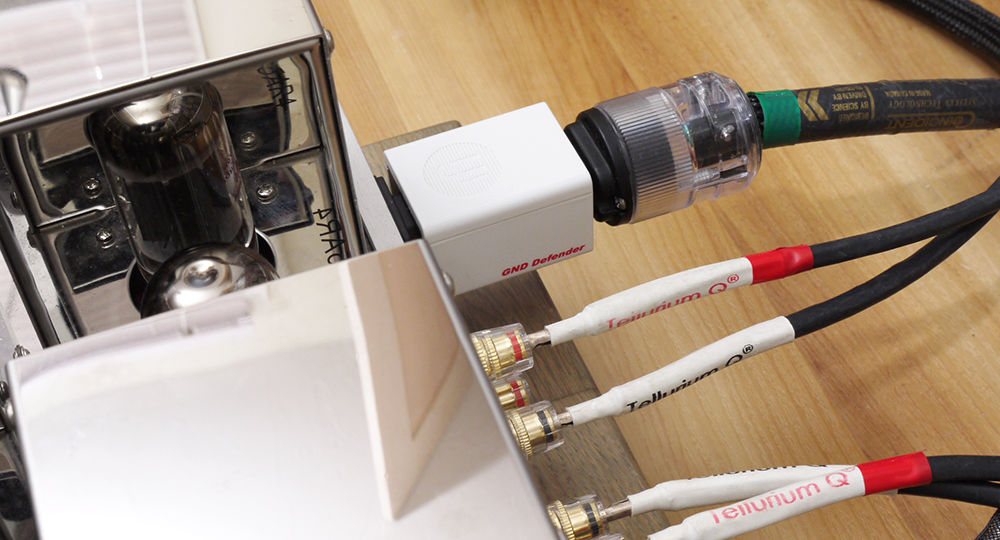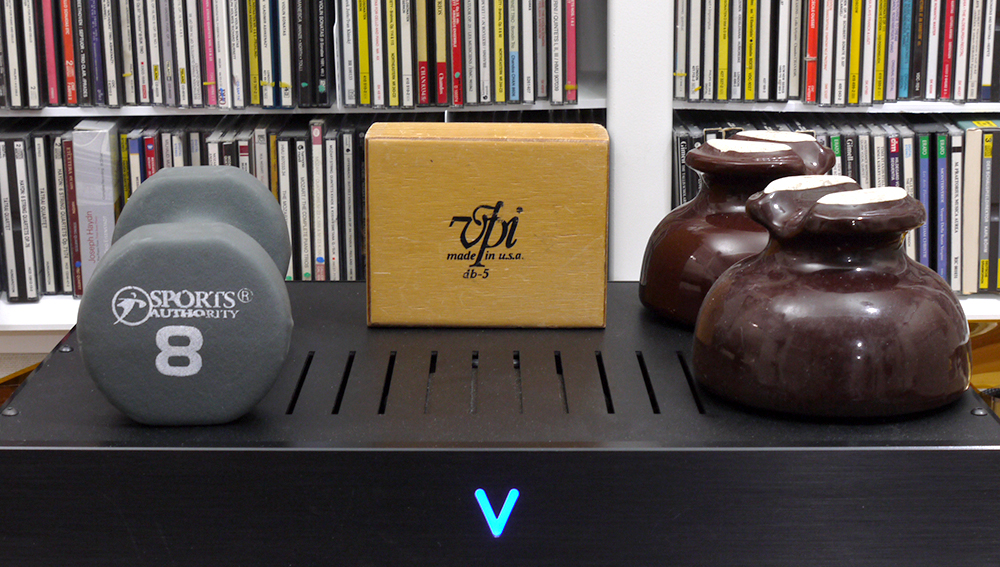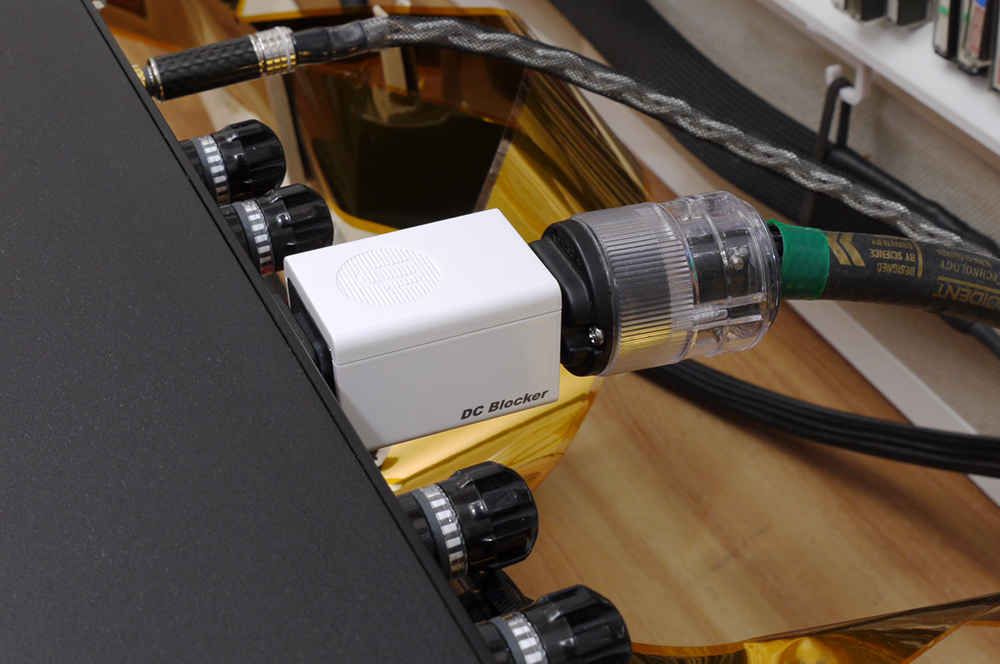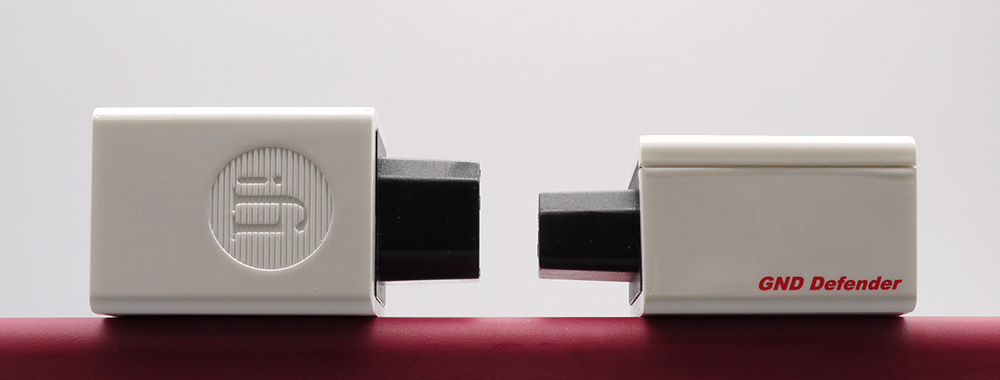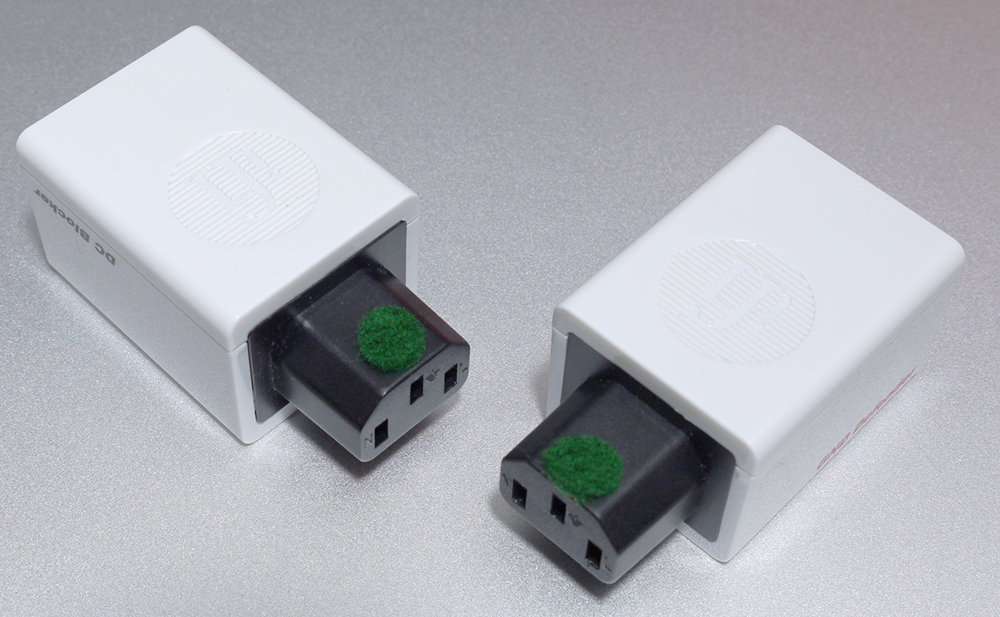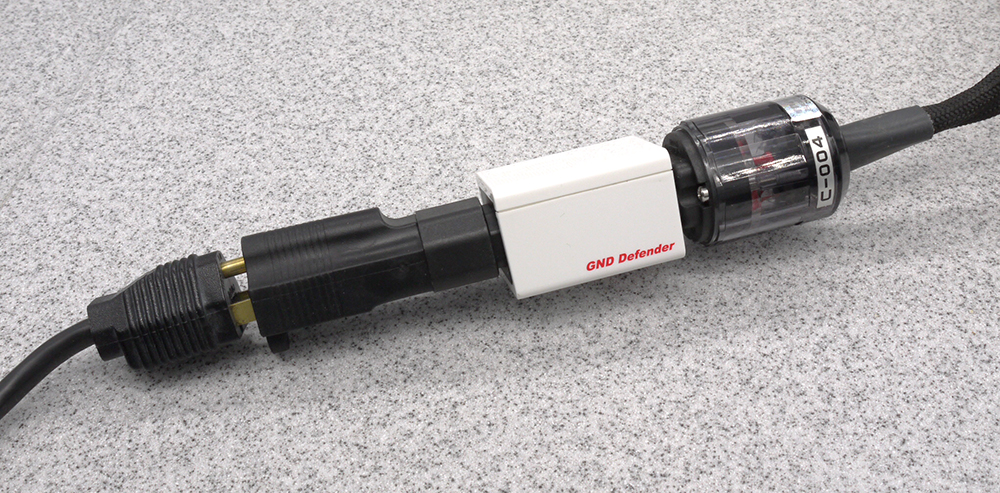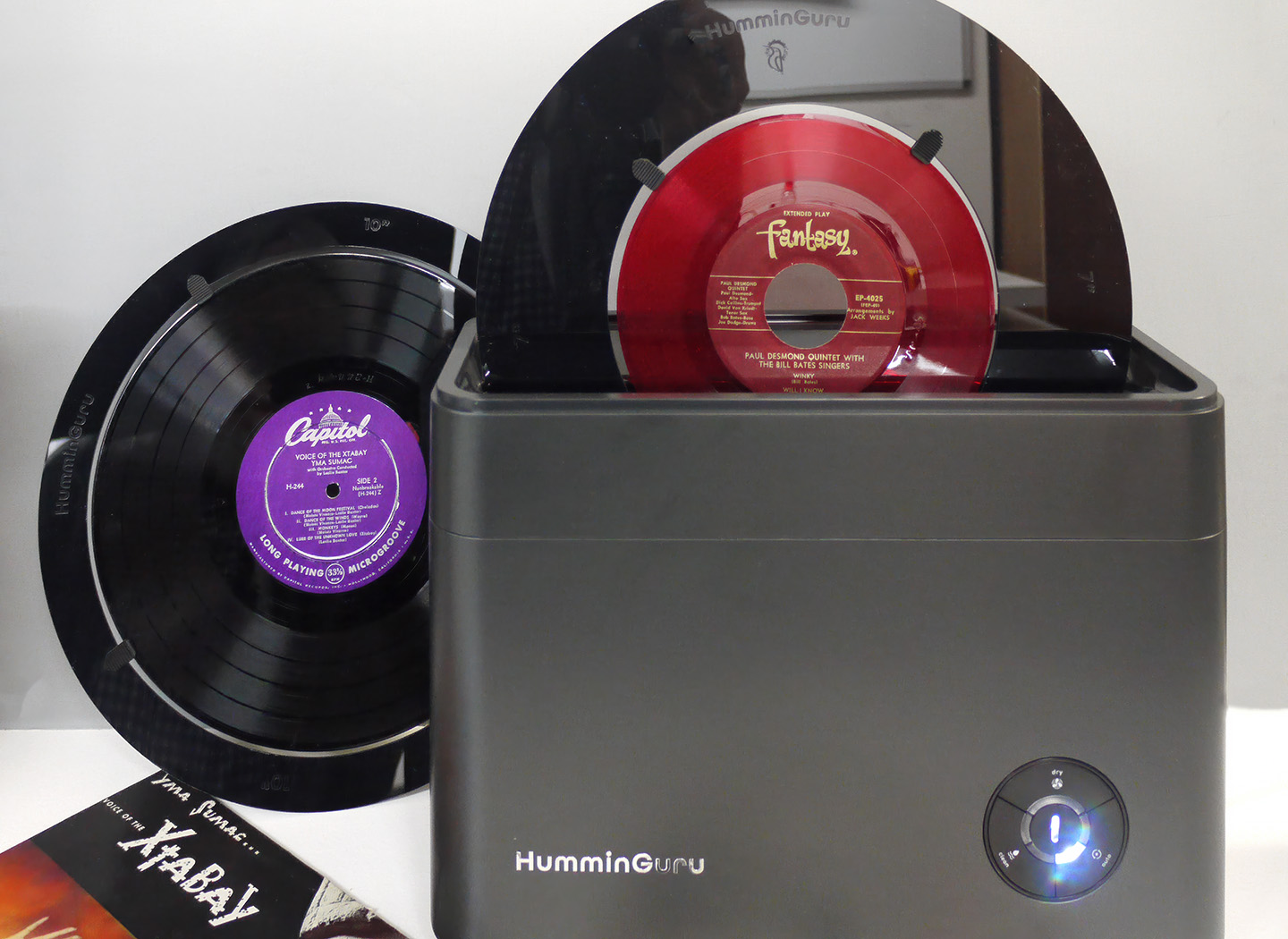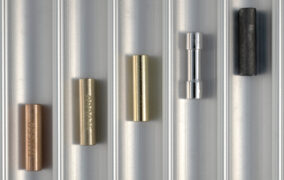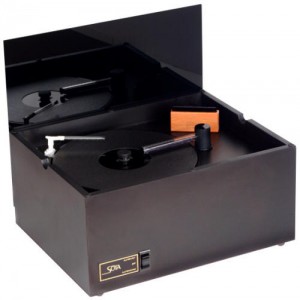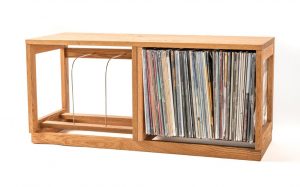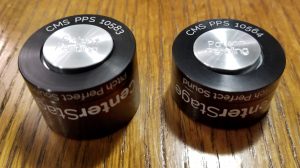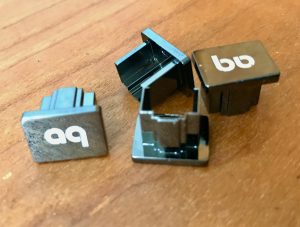I've long been a fan of those wizards at iFi, especially the wonky folks tasked with widget warfare on hi-fi noise pollution. Although perhaps best known for their cost-effective DAC/Headphone amps, iFi has also issued a stream of USB and AC power iPurifiers and iDefenders to address audio problems both common and not so. Of course, in some cases, one doesn't realize how bad a problem is until an iFi gizmo makes it go away. So you just have to try them to find out…audiophiliia nervosa being an essential factor in the business plan of all high-end manufacturers after all.
And so when I saw the announcement that iFi was releasing a couple of AC power iFixes for problems I actually knew I had, I leapt at a chance to audition them in my system. There are also two new iFi AC power cords in their "Silent Power" pipeline—I hope to get to them in a later review. Right now I have in hand an iFi DC Blocker and a GND Defender. Literally in hand. Each weighs but 2.2 oz., measures 2.7" x 1.5" x 1.3", and comes in a card-stock box designed for point-of-purchase rack display in a brick & mortar retail venue (remember those?). For $99 apiece. How could I resist?
Hmm, and just what might these gadgets do? While the iFi USB and AC iPurifiers deal with inaudible high frequency RFI "noise," these little white plastic boxes target the obnoxious hums and buzz you can actually hear. Each has a standard female IEC input on one end, and a male IEC plug on the other. Obviously, not a lot of room inside for circuitry, but then iFi is used to putting miniaturized works in small boxes. No user controls, just plug one into the complaining component, your power cord of choice up its backside, power on, and listen.
I listened mostly with my streaming setup as that allowed easy repeatability. It's a Roon Nucleus streaming Qobuz over Supra Cat8 cable. The latest addition is an Uptone Audio etherREGEN fronting a Sonore ultraRendu (both designed by John Swensen, and clearly separated at birth). From there by various USB cables to a Chord Qutest DAC juiced by an Uptone LPS 1.2. Passive transformer-based Bent Audio preamp, UIT interconnects, Coincident and Valvet amps, Silversmith Fidelium and Tellurium Q Ultra Silver speaker cables, and Spatial Audio Hologram M4 open baffle speakers. Power conditioning by Audience and iFi.
The GND Defender is designed to eliminate a "ground loop" that creates an annoying electronic hum audible through speakers or headphones. But keep in mind not all hum comes from ground loops. Most audio equipment, and particularly tube gear, may have some hum component in their "self-noise" (which is why S/N ratio is important). Hum is also sometimes the result of interactions between unshielded interconnects and power cords-induced EMI, and hence the advice to have signal and power cords cross at right angles. Induced hum is also a common plague in turntable, step-up transformer, and phono stage setups where grounding can be a real bedevilment. And as you are most likely aware, sophisticated (and expensive) grounding gear has become the current "Last Frontier" for noise-adverse audiophiles eager to invest in more cables and components.
All modern US AC circuits are 3-wire (hot, neutral, and ground) to meet electrical code, as are the outlets. That ground wire is connected in a typical residential electrical distribution panel to a bare copper cable running to a copper stake driven into the actual ground. A ground loop occurs when two connected and grounded components take different paths to ground (often because the are on different circuits) and a voltage potential exists between them, creating the hum. What in the US is called ground the Brits call "earth" in part to distinguish it from an audio signal ground, which is why "double insulated" audio products like many turntables, disc players, and even amps and subwoofers can have ungrounded mains cables (even if a 3 prong IEC cord is used with a 2 prong socket). The GND Defender won't work with them.
Since it takes two grounded components to tangle into a ground loop, generations of audiophiles have employed the obvious work-around: "lifting" one ground connection. The piously hypocritical use the familiar 79 cent 3-to-2 prong adapter (intended for This Old House-style 2 slot outlets) but somehow they always forget to connect the copper lug to the outlet's cover plate screw to ground the adapter as intended. We scofflaws just open up the outlet and detach the bare ground wire from the green screw. Best to keep your fire insurance paid up, and remember to reconnect it when selling your domicile and the home inspector arrives with his little circuit checker. The grey area includes audiophile power cords like the PS Audio Statement AC cord that came with my Power Plant Premiere: the ground prong could be unscrewed, a selling feature, not a bug, unless perchance you lose it.
When I set up my basement listening room I had two dedicated 20A lines installed, one behind the amp(s) on the front wall, the second on the back right wall for the source components rack. Knowing I might audition subwoofers, powered speakers, or electrostats needing AC power, I also connected each circuit to a sidewall outlet just beyond the speakers. Everything worked fine with my solid-state amps until I bought the tubalicious Coincident Dynamo 34 SE MK II-and Hello! Ground! Loop! My electrician tried changing the connections at the panel, no luck. Israel Blume of Coincident had checked the amp out—dead quiet he assured me. My power conditioners were of no help, of course: sorry, not my yob.
But no way I was going to strangle an 8-wpc SET tube amp with a cheater plug. Initially I simply ran the Dynamo using the de-pronged PS Audio power cord, and later from the front right hand outlet on the source circuit with the Coincident Statement ST-10 power cord. The Dynamo sounded so good I eventually I added a second duplex outlet above the original dedicated amp outlet, detached its ground wire when nobody was looking, and just moved the Audience aR2p-T4 conditioner depending on which amp was in use. Still, whatever the kluge, there was a bit of residual hum. As the Dynamo is actually an integrated, I settled for backing off its volume pot a bit, reducing any hum to the threshold of inaudibility at the listening seat.
So, imagine my delight when I first installed the GND Defender on the Dynamo, plugged the Coincident Statement power cord into the Audience conditioner on the grounded outlet and realized I could turn the amp's gain all the way up with no ground loop hum! OK, there was just a bit of self-noise audible ear-to-92dB Spatial speaker, but this was a major transformation sonically. I had not realized that even with the gain backed off, the grounding issue was compromising the gutsy little amp's imaging, dynamic range, and resolution.
The iFi GND Defender is not just some stupid overpriced cheater plug. The inner circuitry is "intelligent," automatically lifting the ground on the attached device, but…also automatically reinstating the ground connection to pass current if a fault is detected. So it meets code! The results with the Dynamo far exceeded what I might expect from any other $99 investment I can think of. If a ground loop plagues your setup, this iFixer is a no-brainer.
OK, but what's this about blocking DC? Audiophiles are familiar with the audible benefits of power conditioners that remove RFI/EMI noise from the AC juice flowing out of a wall outlet-but only a very few of them address "DC in the AC," perhaps because such is typically not directly audible through loudspeakers or headphones. DC is what causes transformers to hum, especially the round toroidal ones used in many modern amplifiers. It's a mechanical vibration, not electrical noise. In many cases, what one hears is actually the chassis vibrating in sympathy with the transformer.
When a wire simultaneously conducts low-level DC as well as AC current, the result is a distortion of the AC waveform, called DC offset. Audio gear with transformers just don't like dealing with distorted AC sine waves (which is why PS Audio "regenerators" proudly measure their reduction of it in and out). DC in AC can be continuous, intermittent, or random. The culprits? Could be endemic to the power coming to the house. Could be HVAC, the microwave, or our usual suspects, switch mode power supplies. Like a rash, you know it if you have it.
It's actually the Summer Solstice as I write this. The Coincident Dynamo sports 5 fire-bottles, so it is a good "winter-warmer" in my chilly New England basement. But now comes time to fire up the grill and switch to a solid-state amp. The splendid little Valvet 2se is single-ended class A, but with only one output transistor per channel, it runs cooler than many class AB amps. It's also dual-mono in a single chassis with two hefty toroidal transformers crammed front to back under the top cover in the middle of the slim chassis. In fact, there are thin pads atop the transformers to keep the lid from vibrating. Which it does anyway, a distinct thrummm when powered up, but only a less audible buzz from then on. Otherwise, it's one of the best amps I've ever heard, and seems immune to ground loops to boot!
There are also old-time audiophile fixes for transformer buzz of course. The most famous is one of Harry Weisfeld's first products, the iconic VPI dB-5 Brick. Essentially just a stack of laminated steel plates in a wooden box that one simply puts atop a power transformer, it still seems to engender controversy. Does its 8 lb. of mass simply damp chassis vibrations, or do the steel plates affect stray magnetic fields from the transformer? Or both? Or neither? Only the internet knows.
Whatever. I have one vintage Brick, the Valvet has two transformers. Sure enough, putting 8 lb. on the back toroid knocks down the buzz. Sudden inspiration during the past winter's lockdown: a vinyl covered 8 lb. cast iron dumbbell neatly bridges the two transformers, resulting in even less buzz! Later, testing the magnetic field hypothesis, I tried a pair of 3 lb. ceramic insulators I had used as cable lifts, and that actually became my preference. With any significant added mass the buzz was barely audible within 2 ft. of the amp. But it was there. Bring on the DC Blocker!
Ah, but where the GND Defender was instantly and positively transformative with the Dynamo, not so much the DC Blocker on the Valvet. Yes, straight from the box, the start-up vibration was snubbed in a split-second to an abrupt thwpp, virtually vibration-free silence ensuing, even ear to amp. However, when playing the first tracks it was clear that more than the transformer buzz was gone; the soundstage collapsed, the low bass was truncated, and the whole presentation seemed rather flat and bleached out. Now the Valvet is normally all about huge soundstage and tonal richness top to bottom, so something was awry. Basically, it sounded like I was using a generic stock AC cord, not the excellent Coincident Statement.
So, having just stuck a $99 active device between a few thousand dollars worth of power cord and amp, did I panic? Not when the Second Law of Audiodynamics holds that burn-in heals a host of ills. Unfortunately, the Valvet probably drives the 92 dB Spatials with less than the proverbial first watt, so that was gonna take a while. So I called in some reinforcements: my inefficient Spendor LS3/5a acoustic suspension speakers, hooked up-face to face and connected out of phase to my old high current 200wpc Aragon amp—just to exercise the DC Blocker. Tossed a blanket over the speakers, and cranked up some Cosmic Hippo on repeat 24/7 over a long weekend. Behold: the wall to wall imaging came back after a day or so, the deep bass rolling in a bit later. The mid-range through the highs seemed smoother and more relaxed with the DC Blocker in place. After all, every high-end isolation footer manufacturer will tell you that audio circuit components are themselves affected by vibration, and although iFi makes no such claims, this result might support that notion.
YMMV, but even if you prefer high-wattage amps and inefficient speakers, do give the DC Blocker plenty of break-in. Although the two iFixers share an outer form factor, the GND defender presumably only taps the AC current to support the ground lift/connect circuit. The DC Blocker by contrast actively scrubs DC from the continuous 60 Hz AC sine wave. iFi doesn't detail the technologies involved (licensed from parent company AMR), but they are different animals. Both are rated for 10A loads 90-240v, but the DC Blocker is limited to 7A continuous—enough for most high-end amps, but maybe not for the converted arc-welders you read about in the glossies. For example, while the Dynamo and Valvet are both fused at 3.15A, the mains fuse on the Aragon is 12A, but no problems there as it was just coasting. Finally, despite the plastic carapaces, EMI shielding is maintained with both—your interconnects will be happy with that.
The iFi copy writers describe the IEC connectors as "hospital-grade," but don't look for gold or rhodium plating at $99. One quirk I should mention is that the IEC plugs on the review samples differ slightly from the (pre-production photo shoot?) ones shown on the iFi web pages. Unlike those, or any IEC cords I have at hand, the reviewed units' plugs are tapered on all four sides—look closely at the photo above. This presumably is to ensure universal compatibility. OK, I've struggled on occasion to reach around a rack and blindly orient a stiff power cord IEC at the rear of a component, and the tapers probably do facilitate doing it in the dark. However, the inner contacts are not particularly "grabby." The droop with typical heavy audiophile power cords, runs about 5-7˚, or twice that if you stack the two units (assuming you have both DC offset and a ground loop. iFi is fine with doing that). If you use those $300+ Furutech NCF Cable Booster supports, no problem, of course. I don't, so I did think the degree of droop and lateral wobble worrisome.
My kluge was simple: adding a small green felt furniture surface protector atop the plugs to "mind the gap." I first tried a cork one, but it deteriorated with repeated use, and my hardware store didn't have a vinyl one thin enough (a bit less than 1/16"). The tip of a tapered toothpick taped in place should also work nicely. If, as here, the gizmos will basically take up permanent residence, I'd recommend shimming the sides as well, and using a contact cleaner like DeoxIT before fitting things together snugly. There's also no standard for IEC input location or orientation—the Aragon's is upside-down, my PS Audio Sprout 100's is vertical, and its Bluetooth bulge prevents fully inserting the iFi plugs, but they still makes contact.
Going IEC to IEC keeps the cost down, as there are many AC wall plug configurations around the world, but most modern gear with detachable power cords run with IEC on the equipment end. If you have problematic older/cheaper gear with odd-ball or captive power cords, you can of course have a qualified tech install an IEC input. In the US, you might also consider bookending the iFi cubes with AC to IEC adapters such as the C13 to NEMA 15-5 and NEMA 15-5 to C14.
I only have the C14 adapter which I have used to burn-in daisy-chained power cords. I used it with an IEC power cord to confirm the DC Blocker worked with my Forte Model 3 amp—no problem.
Yes, there may be alternatives to these new gizmos out there, but they all seem more expensive, or more limited in power-handling, or require a second IEC power cord (which if you read these pages, can mean serious money). So what we have here are the rarest of audiophile accessories: technically sophisticated and thoughtfully designed problem solvers, and actually pretty damn affordable. I'll admit I was skeptical at first—my improvised workarounds had made the noise problems inaudible at the listening chair. But the problems were still there, stressing the amps if not the listener. And I was amazed at the improvements that nixing the noise with the iFi Silent Power widgets could bring to an already fine sounding system.
Highly recommended!
iFi Silent Power GND Defender
Retail: $99 USD
iFi Silent Power DC Blocker
Retail: $99 USD
iFi




